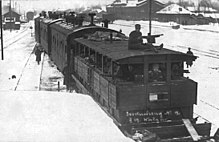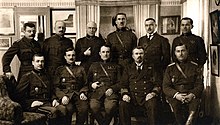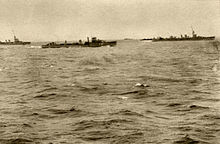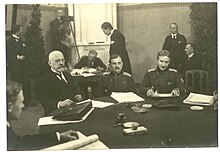Estonian War of Independence
This article needs additional citations for verification. (March 2023) |
| Estonian War of Independence | ||||||||
|---|---|---|---|---|---|---|---|---|
 | ||||||||
| ||||||||
| Belligerents | ||||||||
|
|
|
| ||||||
| Commanders and leaders | ||||||||
|
|
|
| ||||||
| Strength | ||||||||
|
7 January 1919: 4,450[1]–16,500[2] Including
May 1919: 86,000 |
7 January 1919: 5,750–7,250[1] 26 assault guns 3 armoured cars 1 armoured train 141 machine guns[1] May 1919: 80,000[5] | June 1919: 20,000[5] | ||||||
| Casualties and losses | ||||||||
|
3,588 killed[6][7] 15,000 injured[5] |
unknown 10,000 captured[8] |
400 killed 1,500 wounded[9] | ||||||
The Estonian War of Independence,
Preface
During the 1917
After the
Course of the war
Soviet westward offensive
This section needs additional citations for verification. (January 2017) |

In late November 1918, the Bolshevik
The Soviet 6th Red Rifle Division attacked with 7,000 infantry, 22
The Soviet 2nd Novgorod Division opened a second front south of Lake Peipus, with 7,000 infantry, 12 field guns, 50 machine guns, two armored trains, and three armored vehicles.
Estonian military forces at the time consisted of 2,000 men with light weapons and about 14,500 poorly armed men in the Estonian Defence League. The end of November 1918 saw the formation of the Baltic Battalion, primarily a mounted machine-gun company plus infantry. Estonia's
The 49th
By the end of the year, the 7th Red Army controlled Estonia along the front line 34 kilometers east of Tallinn, west from Tartu and south of Ainaži.[3]

He reorganized the forces by setting up the
The national government obtained foreign assistance. On 5 December, Finland delivered 5,000 rifles and 20 field guns along with ammunition.
A British
On 2 January, Finnish volunteer units with 2,000 men arrived in Estonia.
Liberation of Estonian territory

By the beginning of 1919, the Estonian Army had increased its ranks to a total of 13,000 men, with 5,700 on the front facing 8,000 Soviets.[11] The strengthened Estonian Army stopped the 7th Red Army's advance in its tracks between 2 and 5 January 1919 and went on the counter-offensive on 7 January.
Tapa was
In liberating Narva, a 1,000-strong Finnish-Estonian force landed at Utria to the rear of the Soviet 6th Rifle Division on 17 January. In so doing, retreat eastward for the Soviet forces was precluded. The following day Narva was liberated.
Consequent to this the northeastern front stabilized along the Narva river. Within 11 days, the 1st Division had advanced 200 km.[12]
In the southern sphere-of-conflict, Tartu was liberated through the rapid deployment of armored trains and the Tartumaa Partisan Battalion. The 2nd Division continued to advance southwards facing increasing Soviet resistance. In the

The 7th Red Army was routed outside the boundaries of contemporary Estonia and the battle-front continued outwards into the ancient, historical Estonian settlement area.[13] The second half of February saw the Estonian southward advance capture Salacgrīva and Alūksne. This advance was soon stopped by a Soviet buildup ostensibly for a new expansionist offensive into Estonia. On the first Independence Day of 24 February 1919, the pro-independence Estonian forces on the front consisted of 19,000 men, 70 field guns, and 230 machine guns. Estonia had become the first country to repel the Soviet westward offensive.[14]
In the second half of February, the Red armies started the new Soviet offensive to capture Estonia. To this end, the Soviets established what was referred to as the new 'Estonian' Red Army. This sizable force consisted upwards of 80,000 conscripts.
In positions along the Narva River the Estonian 1st Division and their allied
Having received reinforcements, the Estonian 2nd Division counterattacked and regained
On 27 March, the Estonian 3rd Division was deployed along the western flank of the southern front under the command of Major-General Ernst Põdder.[15] At Võru, the situation became critical on 22 April when the Red Army approached to within 1.5 km of the town. Heavy fighting continued at the southeastern front up to the first half of May.
On 25 April, the
Estonian elections and formation of foreign units

On 5–7 April 1919 the
Estonia actively helped to organize White Russian, Latvian and
Offensives into Russia and Latvia

Although the Estonian Army had attained control over its country, the opposing Red armies were still active. The Estonian High Command decided to push their defense lines across the border into Russia in support of the White Russian Northern Corps. On 13 May, the Northern Corps went on the offensive at Narva, catching the Soviets by surprise and destroying their 6th Division.
The offensive of the Estonian Petseri Battle Group began on 24 May. The 600 troops of 1st Estonian Rifle Regiment of the Red Army together with Leonhard Ritt, commander of the

Simultaneously with the Pskov offensive Estonian 2nd and 3rd divisions also started southward offensive into Northern-Latvia. By the end of May they had captured
War against the Landeswehr

The war against the
The Germans disrupted the organization of Latvian national forces, and on 16 April 1919 the Provisional Government was toppled and replaced with the pro-German puppet Provisional Government of Latvia led by Andrievs Niedra.[30][31] Ulmanis took refuge aboard the steamship "Saratow" under Entente protection. The VI Reserve Corps pushed the Soviets back, capturing Riga on 23 May, continued to advance northwards, and demanded that the Estonian Army ended its occupation of parts of northern Latvia. The real intent of the VI Reserve Corps was to annex Estonia into a German-dominated puppet state.

On 3 June, Estonian General Laidoner issued an ultimatum demanding that German forces must pull back southwards, leaving the
The Estonian 3rd Division continued their advance towards Riga. On 3 July, when the Estonian forces were at the outskirts of Riga, a ceasefire was made on the demand of the Entente and the Ulmanis government was restored in Riga. The German forces were ordered to leave Latvia, the Baltische Landeswehr was put under the command of the Latvian Provisional Government and sent to fight against the Red Army. However, to circumvent Entente's orders, the troops of the disbanded VI Reserve Corps, instead of leaving, were incorporated into the West Russian Volunteer Army, officially hired by the German puppet Government of Latvia and led by Pavel Bermondt-Avalov.[13] In October, fighting restarted when the West Russian Volunteer Army attacked Riga. Following the Latvian request to help, Estonia sent two armoured trains to aid repelling the German attack. The Estonian army also remained to support the defence of Latvia against Soviets by defending the front north of Lake Lubāns.[33]
Final battles and peace negotiations

- From upper left:
- Major General Ernst Põdder
- Dr. Arthur Lossmann
- Major General Aleksander Tõnisson
- Colonel Karl Parts
- Colonel Viktor Puskar
- Colonel Jaan Rink
- From bottom left:
- Major General Andres Larka
- Major General Jaan Soots
- Commander-in-chief Lieutenant General Johan Laidoner
- Admiral Johan Pitka
- Colonel Rudolf Reimann
Soviet Russia had been attempting to conclude a peace since the spring of 1919. On 25 April 1919, Hungarian Communists offered to mediate a settlement between the Bolsheviks and the Estonians, but Admiral Cowan threatened withdrawal of support to the Estonians unless they rejected the Hungarian offer.[34] The Russians then publicly broached the subject of peace talks in a radio broadcast on 27 and 28 April. On 5 June the Estonian Commune was abolished. A subsequent broadcast by the Russians on 21 July led to the British journalist Arthur Ransome sounding out the Commissar for Foreign Relations Georgy Chicherin on the subject of peace talks. As a result, the Soviet government made a formal offer for negotiations on 31 August 1919. The Estonians accepted on 4 September, and delegations started talks on 16 September. Estonia then proposed to stop the negotiations until Latvia, Lithuania and Finland have agreed to participate in joint negotiations.[35]
In the autumn, the Northwestern Army launched operation White Sword, a major effort to capture

The 7th and 15th Soviet Armies advancing behind collapsing White Russian forces
On 19 November, the new government of Jaan Tõnisson decided to restart talks with Soviet Russia, even without the participation of other Baltic countries.[41] Negotiations began on 5 December, with the main point of dispute being territorial issues. Talks continued through December, with both sides pressing their territorial demands, while heavy fighting continued at Narva. The peace treaty was finally concluded on 31 December 1919, and the ceasefire came into effect on 3 January 1920.[42]
Foreign assistance

Foreign assistance, mostly from the United Kingdom and Finland, played a very important role during the early stages of war.
British naval and air forces arrived in December 1918, after lobbying in London by Estonian politicians. At this time, the new Estonian government was weak and desperate, and the Estonian Prime Minister even asked that his state be declared a British protectorate, but Britain would not meet this plea.[43] However, the British squadron delivered 6500 rifles, 200 machine guns, and 2 field guns. In addition, 2 Soviet destroyers were captured near Tallinn and turned over to Estonia. A Royal Navy squadron continued to provide artillery support on the coast and also protected the Estonian flank against the Russian Baltic Fleet. The United Kingdom remained Estonia's main supplier of arms and equipment throughout the war.
While the British navy provided considerable support, the historian William Fletcher concludes that, "the British naval force would have had little effect on the outcome of Baltic affairs had not the Estonians and Latvians provided a vibrant and disciplined land and sea force".[39] The British contributed 88 ships to the Baltic campaign, of which 16 were sunk.[44] 128 British servicemen died in the campaign, 9 were captured and at least 27 were wounded.[44]

Concerned with having Bolshevik rule in the South, Finland delivered funds and weapons.[45] Finland provided 5000 rifles and 20 field guns by 12 December. Finland also sent 3500 volunteers. Pohjan Pojat led by Hans Kalm fought at the Southern Front, including at the Battle of Paju, while I Suomalainen Vapaajoukko led by Martin Ekström fought at the Viru Front, including at the Battle of Utria. Finnish volunteers returned to Finland on March–April 1919, having lost 150 men.
The
The Swedish volunteer unit under the command of
Tartu Peace Treaty

On 2 February 1920, the Peace
See also
- Timeline of the Estonian War of Independence
- History of Estonia
- Latvian War of Independence
- Lithuanian Wars of Independence
- Ukrainian War of Independence
- Finnish Civil War
- Cross of Liberty
- War of Independence Victory Column
- Commemorative Medal for the Estonian War of Independence
- Vaps Movement
- Names in Marble
- The Young Eagles
Notes
- ^ Naval support
- ^ Although many Baltic Germans fought against the Republic of Estonia as part of the Baltische Landeswehr, one regiment originally formed by ethnic German students fought as part of the Estonian Army until 1920, when it was disbanded.[4]
- ^ Estonian: Vabadussõda (literally "Freedom War")
- Soviet Russia.
References
- ^ a b c d e Jaan Maide (1933). "IV" (PDF). Ülevaade Eesti Vabadussõjast (1918–1920). Tartu: Kaitseliidu kirjastus.
- ^ a b Kaevats, Ülo: Eesti Entsüklopeedia. Valgus, 1990 http://entsyklopeedia.ee/artikkel/vabaduss%C3%B5da1
- ^ a b c d Jaan Maide (1933). "II" (PDF). Ülevaade Eesti Vabadussõjast (1918–1920). Tartu: Kaitseliidu kirjastus.
- ^ Thomas & Boltowsky (2019), p. 20.
- ^ a b c d "Iseseisvuse aeg 1918–40". Eesti. Üld. Vol. 11. Eesti entsüklopeedia. 2002. pp. 296–311.
- ^ "Vabadussoja Ajaloo Selts".
- ^ "Kaitsevägi mälestab Vabadussõjas langenuid - Kaitsevägi". Archived from the original on 14 October 2019. Retrieved 11 November 2017.
- ^ ISBN 5-89900-054-6
- ISBN 5-89900-009-0
- ^ Estonian Declaration of Independence 24 February 1918 Archived 22 May 2009 at the Wayback Machine
- ISBN 5-450-01325-6
- ISBN 5-450-01325-6
- ^ a b c d e Estonian War of Independence 1918–1920. Jyri Kork (Ed.). Esto, Baltimore, 1988 (Reprint from Estonian War of Independence 1918-1920. Historical Committee for the War of Independence, Tallinn, 1938)
- ISBN 5-450-01325-6
- ^ "Kaitseväe ajalugu". Archived from the original on 8 February 2009. Retrieved 29 September 2009.
- ISBN 5-450-01325-6
- ISBN 0-8108-4904-6
- ISBN 5-450-01325-6
- ISBN 978-0-313-32355-3
- ISBN 5-450-01325-6
- ISBN 5-450-01325-6
- ISBN 5-450-01325-6
- ISBN 5-450-01325-6
- ISBN 5-450-01325-6
- ISBN 9780817928520
- ISBN 5-450-01325-6
- ^ ISBN 5-450-01325-6
- ISBN 9780912881003
- ISBN 9781851094202.
- ISBN 5-450-01325-6
- ISBN 0-521-66157-9
- ISBN 5-450-01325-6
- ISBN 5-450-01325-6
- Monterey, California. Archived from the original(PDF) on 16 September 2008. Retrieved 24 July 2008.
- ISBN 5-450-01325-6
- ^ Операция "Белый меч" /28 сентября – 23 октября 1919 года/ Белая гвардия website
- ISBN 5-450-01325-6
- ^ "Krasnaja Gorka Operation 13 October – 9 November 1919 (Baltic Military History Newsletter)" (PDF). baltdefcol.org. Baltic Defence College. October 2014. Archived from the original (PDF) on 28 January 2015. Retrieved 24 January 2015.
- ^ a b Fletcher, William A. The British navy in the Baltic, 1918–1920: Its contribution to the independence of the Baltic nations, Journal of Baltic Studies, 1976, pp134 - 144
- ISBN 5-450-01325-6
- ISBN 5-450-01325-6
- ^ Georg von Rauch, The Baltic States: The Years of Independence 1917–1940, Hurst & Co, 1974, p70
- ^ Kinvig, p. 138
- ^ a b Kinvig, p. 289
- ^ Tepora & Roselius 2014, p. 138.
Works cited
- Kinvig, Clifford, Churchill's Crusade: The British Invasion of Russia 1918–1920, London 2006, ISBN 1-85285-477-4.
- Tepora, Tuomas; Roselius, Aapo, eds. (2014). The Finnish Civil War 1918: History, Memory, Legacy. Leiden: Brill. ISBN 9789004280717.
- Thomas, Nigel; Boltowsky, Toomas (2019). Armies of the Baltic Independence Wars 1918–20. Oxford: Osprey Publishing. ISBN 9781472830777.
External links
- Estonica: Estonian War of Independence Archived 12 May 2017 at the Wayback Machine
- "The Baltic States from 1914 to 1923: The First World War and the Wars of Independence" (PDF). Archived from the original (PDF) on 8 August 2019. Retrieved 29 December 2012. (1.24 MiB) - in Baltic Defence Review No.8 Volume 2/2002
